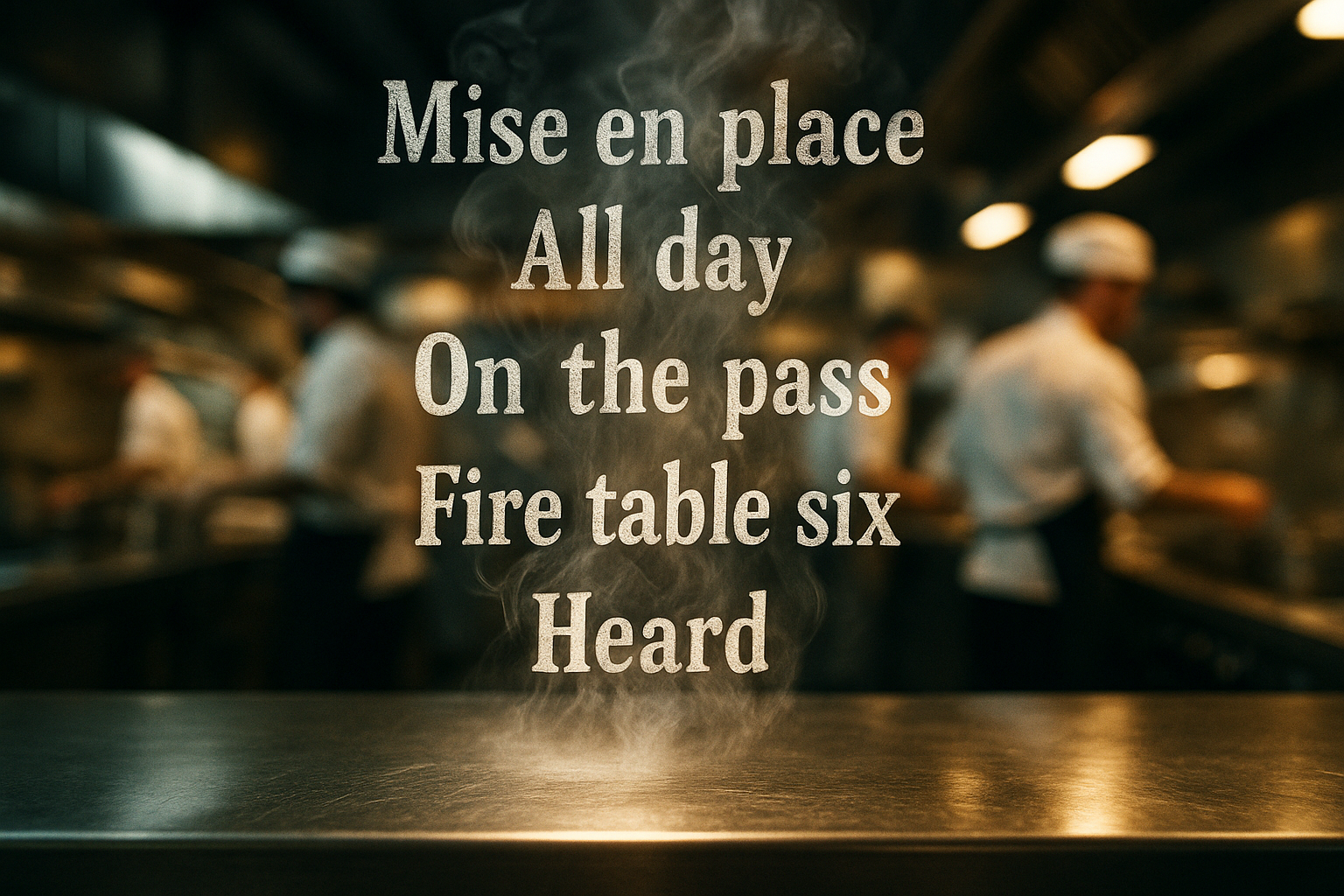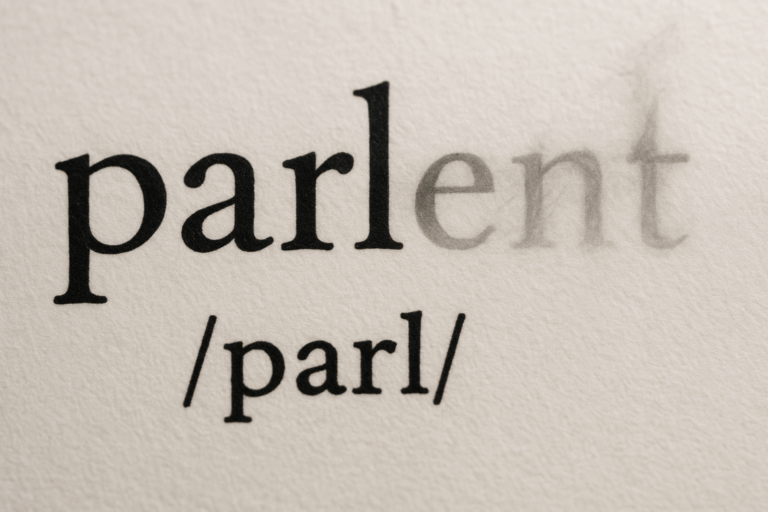The air is thick with heat, steam, and the percussive clang of metal on metal. A printer spits out tickets with an insistent chatter, each one a new demand. Over the symphony of sizzling pans and the roar of exhaust fans, a series of clipped, coded phrases cuts through the noise: “Fire table four, two salmon, one steak mid-rare!” “Oui, Chef!” “How long on that risotto?” “Two minutes out!” “Behind you, hot!”
This isn’t just noise; it’s a language. Welcome to the professional kitchen, a linguistic pressure-cooker where communication has been stripped down, supercharged, and forged into a specialized dialect. This kitchen-speak—a mix of French tradition, military brevity, and evocative slang—is more than just jargon. It’s a high-stakes sociolect, a system designed for maximum clarity and efficiency in an environment where seconds can mean the difference between a perfectly seared scallop and a culinary disaster.
A Language Forged in Fire
Why does such a unique lexicon even exist? Because a busy restaurant kitchen is one of the most demanding workplaces on earth. It’s hot, crowded, and filled with sharp knives and boiling liquids. During the dinner rush, a team of cooks must execute dozens of complex, multi-component dishes simultaneously, all while adhering to exacting standards. Normal, conversational English is a luxury they can’t afford; it’s too slow, too polite, and dangerously ambiguous.
Kitchen language serves several critical functions:
- Speed: Shorthand saves time. Shouting “On the fly!” is faster and more urgent than saying, “A customer just ordered this, and they need it as quickly as humanly possible.”
- Clarity: There is no room for misinterpretation. “Behind!” is an unambiguous warning that prevents collisions and burns. It’s a purely functional utterance stripped of all pleasantries.
- Hierarchy: The language reinforces the rigid chain of command. The constant refrain of “Oui, Chef!” or “Heard!” isn’t just an acknowledgment; it’s a verbal salute that confirms an order has been received and will be executed by a subordinate.
- Cohesion: Like any specialized jargon, it builds a sense of identity and camaraderie. Speaking the language means you’re part of the tribe, a seasoned professional who understands the rhythm and rules of the line.
The French Connection: Echoes of the Brigade
To understand modern kitchen slang, you have to go back to its architect: Auguste Escoffier. At the turn of the 20th century, the legendary French chef revolutionized professional cooking by introducing the brigade de cuisine, or the kitchen brigade system. He modeled his kitchen on the military, establishing a clear hierarchy with specific roles and stations (saucier, garde manger, pâtissier, etc.), all reporting to the chef de cuisine.
This military structure demanded a language to match—one of command and response. French, being the international language of diplomacy and haute cuisine at the time, became its foundation. Many of these foundational terms are still non-negotiable parts of the kitchen lexicon today:
- Mise en place: Literally “everything in its place.” This refers to the entire setup and prep work a cook does before service begins. It’s the foundational principle of kitchen organization.
- À la minute: “To the minute.” It means an item is cooked to order, not prepared in advance.
- Sous Chef: The “under-chef,” second in command.
- All-day: A direct translation of the French à la journée, meaning the total number of a particular dish needed. A cook might hear, “We have four orders for chicken, so I need eight chicken breasts on the grill all-day.”
The continued use of these French terms is a nod to tradition, but it’s also functional. They are precise, universally understood in high-end kitchens, and carry the weight of culinary history.
The Anatomy of a Service: A Kitchen Lexicon
While French provides the foundation, English slang brings the dynamism. During a service, the air is filled with terms that paint a vivid picture of the kitchen’s status.
The most famous of these is “86” (eighty-sixed), meaning an item is sold out or no longer available. Its origin is the stuff of culinary legend, with theories ranging from a Prohibition-era speakeasy (Chumley’s at 86 Bedford Street in NYC) that would usher patrons out a back entrance when police arrived, to the standard proof of rum (86) that was often tossed out, to the grim code for a freshly dug grave (8 feet long, 6 feet deep). Whatever its origin, when the chef yells “86 the halibut!” everyone from the line cooks to the servers knows it’s off the menu.
Other key terms orchestrate the flow of the meal:
- On the fly: An order needed immediately, usually because of a server’s mistake or a special request. It jumps the queue and puts pressure on the line.
- In the weeds: A cook is overwhelmed, drowning in orders and falling behind. This is a cry for help or a warning to others.
- Fire: The command from the chef or expeditor to begin cooking a specific dish or table’s order. This is the trigger that sets the cooking process in motion.
- Hands!: A call for a server or food runner to come to the pass (the shelf where finished dishes are placed) to pick up food that is ready to be taken to the dining room. It’s an urgent plea to get the food out while it’s perfect.
- Dying on the pass: A finished dish that is sitting too long waiting for pickup, losing its ideal temperature and texture. This is the tragic outcome that “Hands!” is meant to prevent.
More Than Just Words: The Pragmatics of the Kitchen
Linguistically, what makes kitchen-speak so fascinating is its pragmatics—the way context shapes meaning. The vocabulary is just one layer. The tone, volume, and rhythm are equally important. A calm “Heard, Chef” is different from a strained, breathless “Heard!” A chef’s “Let’s push, people!” can be either encouragement or a stern warning, depending on the edge in their voice.
The entire system functions as a series of call-and-response loops. An order is called, and it must be echoed back. This verbal confirmation closes the communication loop, ensuring the message was not lost in the din. This constant back-and-forth creates a unique cadence, a rhythm that powers the kitchen through the chaos of service.
So the next time you’re in a restaurant with an open kitchen, listen closely. You’re not just hearing noise. You’re hearing a highly evolved, purpose-built language in action—a testament to how humans adapt communication for survival in one of the world’s most intense and demanding environments. Every “Oui, Chef!” and frantic “86!” is a word freighted with history, pressure, and precision.








